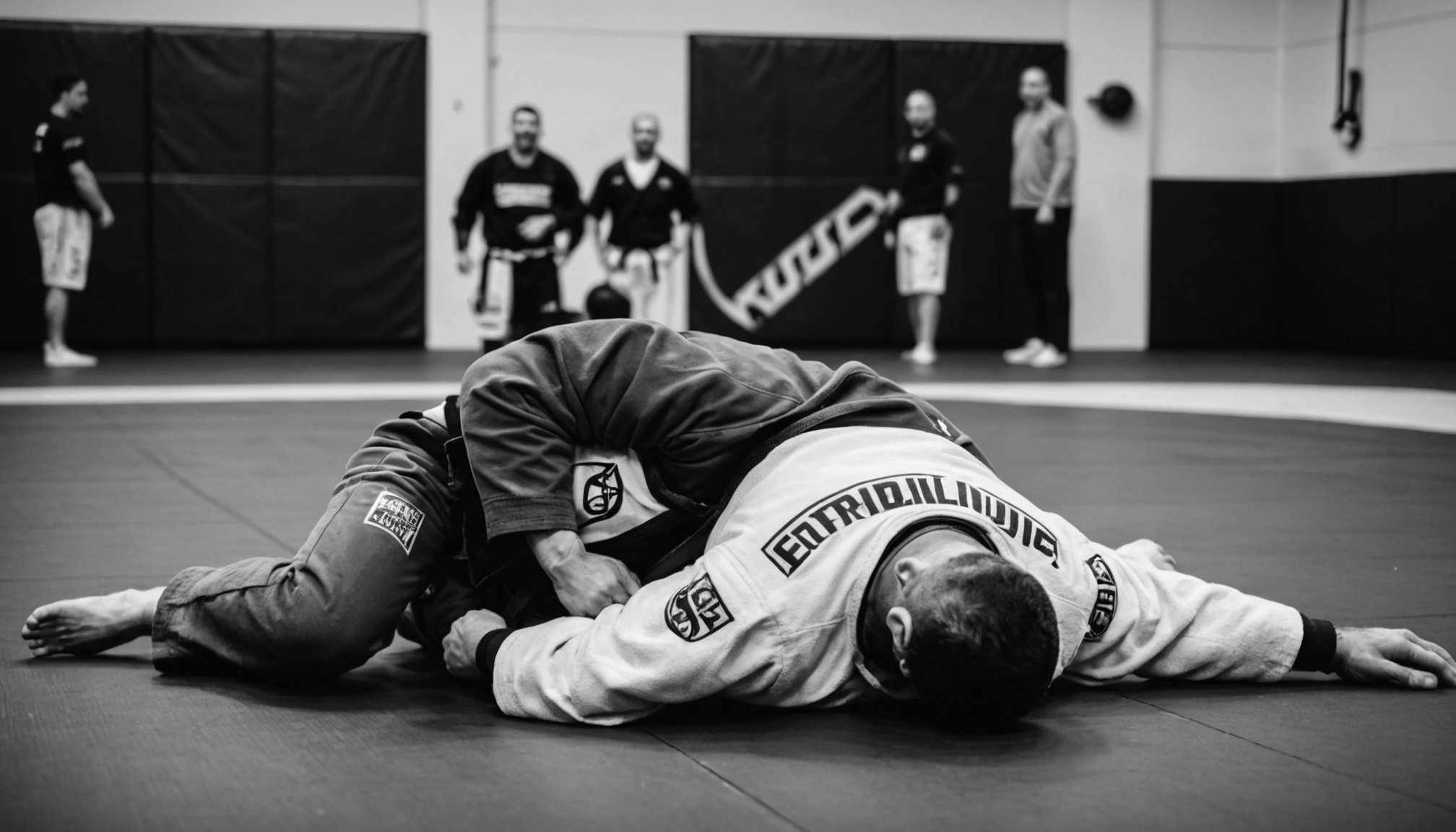Unlocking the Advantages of Cross-Training in Brazilian Jiu-Jitsu for Wrestlers in the UK: A Path to Enhanced Performance to Cross-Training in BJJ
For wrestlers in the UK, incorporating Brazilian Jiu-Jitsu (BJJ) into their training regimen can be a game-changer. BJJ, a martial art and combat sport that focuses on grappling and ground fighting, offers a unique set of skills that can enhance a wrestler’s overall performance. This article will delve into the benefits of cross-training in BJJ, providing practical insights, actionable advice, and real-world examples to help wrestlers leverage this powerful training method.
Understanding the Benefits of BJJ for Wrestlers
Enhanced Ground Game
One of the most significant advantages of BJJ for wrestlers is the improvement in their ground game. Wrestling primarily focuses on takedowns and controlling positions on the mat, but it often lacks the depth of ground fighting techniques that BJJ provides. By training in BJJ, wrestlers can learn how to transition seamlessly from standing to ground positions, improve their escapes, and master submission holds and joint locks.
This might interest you : Integrating Mindfulness in UK Martial Arts: Enhancing Curriculum with Mindful Practices
“BJJ training has been instrumental in my wrestling career,” says David Avellan, creator of the Kimura Trap System and ADCC 2009 Bronze Medalist. “It has helped me develop a more well-rounded skill set, especially in situations where the fight goes to the ground”[2].
Increased Athleticism
BJJ training is known for its intense physical demands, which can significantly increase an athlete’s overall athleticism. The combination of strength, flexibility, and cardiovascular endurance required for BJJ can enhance a wrestler’s performance in several key areas.
Also to see : Unlocking Explosive Power: A Guide to Plyometric Training for UK Wrestlers
- Strength and Endurance: BJJ involves a lot of strength-based movements, such as lifting and controlling opponents, which can build muscular strength and endurance.
- Flexibility and Mobility: The dynamic movements in BJJ, such as rolling and transitioning between positions, improve flexibility and mobility.
- Cardiovascular Fitness: BJJ training sessions are often high-intensity, which can improve cardiovascular fitness and increase stamina.
Mental Toughness and Discipline
Training in BJJ also fosters mental toughness and discipline, essential qualities for any athlete. The sport requires a high level of focus, resilience, and strategic thinking, all of which can translate to improved performance in wrestling.
“BJJ has taught me how to stay calm under pressure and think strategically during a match,” notes Chris Paines, a BJJ Black Belt from England. “These skills are invaluable in any combat sport”[2].
How to Integrate BJJ into Your Wrestling Training
Creating a Balanced Training Schedule
To reap the benefits of BJJ, wrestlers need to integrate it into their existing training schedule without compromising their wrestling practice. Here are some tips for creating a balanced training schedule:
- Alternate Training Days: Alternate between wrestling and BJJ training days to avoid overtraining and allow for adequate recovery time.
- Focus on Specific Skills: Identify specific skills in BJJ that can complement your wrestling training, such as guard passes or submissions, and focus on those during your BJJ sessions.
- Cross-Training Sessions: Incorporate cross-training sessions that combine elements of both wrestling and BJJ, such as live drilling or scenario training.
Key BJJ Techniques for Wrestlers
Here are some key BJJ techniques that wrestlers can benefit from:
- Guard Passes: Learning to pass the guard effectively can help wrestlers control and dominate their opponents on the ground.
- Knee Slide: A technique where you slide your knee across the opponent’s thigh to pass the guard.
- Torreando Pass: A pass where you use your feet to push the opponent’s legs aside.
- Submissions and Joint Locks: Mastering submissions and joint locks can provide wrestlers with additional ways to finish matches.
- Armbar: A submission where you hyperextend the opponent’s arm.
- Kimura: A shoulder lock that can be used to submit or control the opponent.
- Escapes: Learning to escape from bad positions can help wrestlers avoid being submitted or controlled.
- Guard Recovery: Techniques to recover the guard from a passed position.
- Side Control Escapes: Methods to escape from side control, such as bridging or using underhooks.
Practical Insights and Actionable Advice
Dealing with Bigger and Stronger Opponents
One common challenge wrestlers face when training in BJJ is dealing with bigger and stronger opponents. Here are some practical tips:
- Use Technique Over Strength: Focus on using technique rather than relying on brute strength. Techniques like the cross-collar grip and 2-on-1 control can be particularly effective[5].
- Be Proactive: Being proactive and controlling the pace of the match can help smaller wrestlers manage larger opponents.
- Master Key Positions: Mastering key positions such as side control and back control can provide smaller wrestlers with leverage over larger opponents.
Reducing Injuries and Building a Bulletproof Physique
Injury prevention is crucial for any athlete, and BJJ training can help build a more resilient physique. Here are some tips:
- Warm-Up and Cool-Down: Always include thorough warm-up and cool-down sessions to prevent injuries.
- Conditioning Exercises: Incorporate conditioning exercises that target the muscles used in BJJ, such as core strength and flexibility exercises.
- Listen to Your Body: Pay attention to your body and take rest days when needed to avoid overtraining.
Resources for Cross-Training in BJJ
Instructional Videos and Apps
For wrestlers looking to start or enhance their BJJ training, there are several resources available:
- BJJ Fanatics: Offers instructional videos from top BJJ fighters and teachers, available online or through their app[4].
- BJJ Apps: Apps like the BJJ Fanatics app provide access to a wealth of instructional content, drills, and training plans.
Podcasts and Community
Engaging with the BJJ community through podcasts and online forums can provide valuable insights and support:
- Beauty and the Gi: A podcast that explores the intersection of life on and off the mat, offering personal experiences and practical advice[2].
- Reddit r/BJJ: A community forum where wrestlers can ask questions, share experiences, and get tips from other practitioners[5].
Cross-training in BJJ can be a powerful tool for wrestlers in the UK, offering a range of benefits from enhanced ground game skills to increased athleticism and mental toughness. By integrating BJJ into their training schedule, wrestlers can become more well-rounded athletes, better equipped to handle the demands of their sport.
Here is a summary of the key points in a detailed bullet point list:
- Enhanced Ground Game:
- Learn to transition from standing to ground positions.
- Improve escapes and master submission holds and joint locks.
- Increased Athleticism:
- Build muscular strength and endurance.
- Improve flexibility and mobility.
- Enhance cardiovascular fitness.
- Mental Toughness and Discipline:
- Develop focus, resilience, and strategic thinking.
- Balanced Training Schedule:
- Alternate between wrestling and BJJ training days.
- Focus on specific skills that complement wrestling.
- Key BJJ Techniques:
- Guard passes (knee slide, torreando pass).
- Submissions and joint locks (armbar, kimura).
- Escapes (guard recovery, side control escapes).
- Dealing with Bigger Opponents:
- Use technique over strength.
- Be proactive and control the pace.
- Master key positions (side control, back control).
- Reducing Injuries and Building a Bulletproof Physique:
- Include thorough warm-up and cool-down sessions.
- Incorporate conditioning exercises.
- Listen to your body and take rest days when needed.
By embracing these strategies and resources, wrestlers can unlock the full potential of cross-training in BJJ, leading to enhanced performance and a more successful athletic career.
Table: Comparing the Benefits of BJJ and Wrestling Training
| Benefit | BJJ Training | Wrestling Training |
|---|---|---|
| Ground Game | Emphasizes ground fighting, submissions, and joint locks. | Focuses on takedowns and controlling positions on the mat. |
| Athleticism | Increases strength, flexibility, and cardiovascular endurance. | Enhances strength, power, and agility. |
| Mental Toughness | Develops focus, resilience, and strategic thinking. | Builds discipline, determination, and competitive spirit. |
| Injury Prevention | Helps build a resilient physique through conditioning exercises. | Includes strength and conditioning exercises to prevent injuries. |
| Technique Variety | Offers a wide range of techniques including guard passes, submissions, and escapes. | Focuses on takedowns, throws, and controlling positions. |
| Cross-Training Benefits | Enhances wrestling performance by improving ground game and increasing athleticism. | Complements BJJ by improving takedown skills and overall athleticism. |
This table highlights the complementary nature of BJJ and wrestling training, demonstrating how each can enhance the other to create a more well-rounded and effective athlete.











